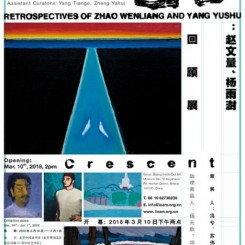Crescent: Retrospectives
Beijing Inside-Out Art Museum
[Press Release]
Exhibition Dates change to: March 24 – July 1, 2018
Curators: Feng Xi, Su Wei
Assistant Curators: Yang Tiange, Zheng Yahui
Zhao Wenliang (1937–, born in Harbin) and Yang Yushu (1944–, born in Beijing) were both born before 1949, when the People’s Republic of China was founded. They were the central figures of the Yuyuantan School of Painting emerged in the late 1960s and the No Name (Wuming) Group in the 1970s. They have experienced the changes China has undergone in social history and artistic discourses from 1949. The two met in the late 1950s when they were learning painting. Zhao began mentoring Yang in 1961, and their relationship has since been one of mentor and student as well as of friendship. They have lived a hard life, struggling financially. Painting has been the most important thing for them and their only hope.
How to present a case study of these two artists who have had such a long career is indeed a challenge. Their practice dates back to the 1950s and their entire work, which spans decades, offers a unique insight into China’s social transformation and artistic revolution from the 1950s to the present day. Having never studied or worked in a state fine arts institution in any form, Zhao and Yang have always been marginalized in the Chinese artists’ community. Their peripheral status is reinforced as their identity as amateur painters has often been questioned. However, their circumstances also kept them at a distance from the pedagogy, painting methods and ideology promoted in the state fine arts institution. As self-taught painters, Zhao and Yang have been exploring their own artistic practices. Financial hardships did not stop them from holding themselves to exacting standards in their work. Indeed, art historians today still tend to label their work as “aesthetic,” “modernist,” “impressionist,” and “Matisse-inspired.” These contradictions present a major challenge to us curators. How do we represent the inevitable yet extraordinary contradiction between their life and art in this project? Their work reflects the institutionalization and the changes of discourse in Chinese fine arts since 1949. How to consider these artists’ relationship with the authoritative framework of the state from a historical and critical perspective forms the most crucial theoretical task of this exhibition.
The title of the exhibition, Crescent, is borrowed from the name of the Crescent Moon Society, a literary and political group founded in the Republican era of China in 1923. The Crescent Moon Society promoted liberal, modernist work and discussions and advocated the primacy of technique and form, thus contrasting sharply with the Left, who endorsed literature that served the proletariats. After the People’s Republic was established in 1949, the voice the “Crescent Moon” represented became increasingly low and more of an undercurrent. Crescent, as the title of this exhibition, is a metaphor that relates to changing times and spaces, a start of the story that we are telling here through these two individual artists. Through research, exploration, and re-imagination, this exhibition hopes to examine how historical and aesthetic experiences are formed, interpreted, and applied, aiming to provide an alternative perspective to consider the context where the inherence of individual artists was formed and the effect of the repressive historical experiences on our work, values, and ideas in China’s art world today.


